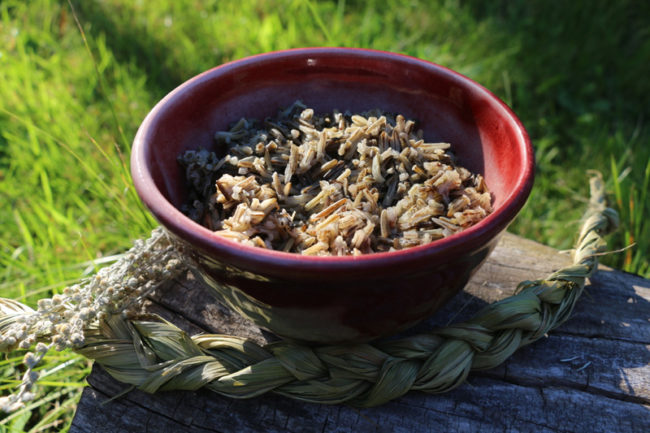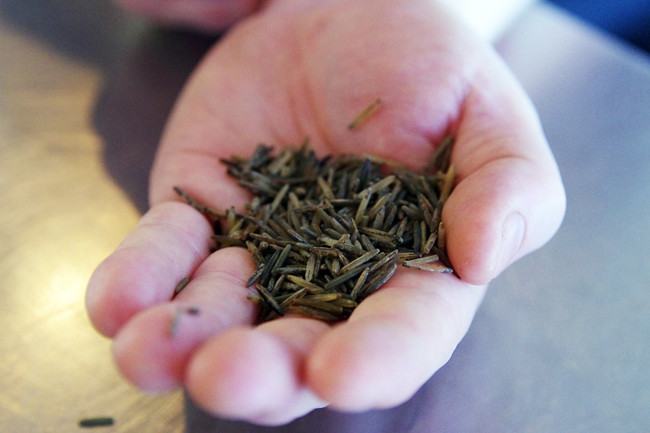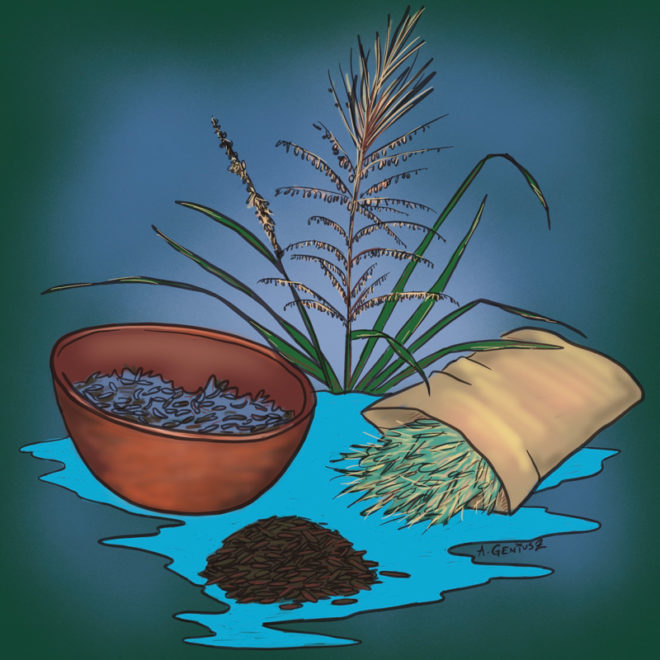There is an Aadizookaan, one of our ancient sacred stories, that tells about how the Anishinaabeg, the Ojibwe people and those tribes related to them, came to the Great Lakes Region. That Aadizookaan says that our ancestors were told to travel east until they came to the place where “food grows on water.” When they found Manoomin [1], whose stalks of seeds grow up through and then ripen over the water, they knew they had found their new home. Manoomin is not a “rice,” although English and French speakers have long confused the two, calling manoomin “wild rice” and “riz sauvage.” Manoomin cooks differently from white and brown rice, and non-native scientists classify manoomin as a “cereal.” When speaking English, Native people have come to call the harvesting of manoomin “ricing,” and yes we do sometimes call it “rice” as well. (Fun fact: we call white rice: waabishkii-manooomin, which literally means “white colored manoomin.”).
We are just at the middle, or end of, depending on where one lives, Manoominike-giizis, the Ricing Moon, and soon manoomin will be for sale in and around Ojibwe communities in Wisconsin, Minnesota, and other places in the Great Lakes Region. The price of actual, hand harvested manoomin from Native communities is higher than paddy-rice, the genetically modified “wild rice,” which has been the subject of much debate in the Minnesota courts. The difference in price reflects not only that year’s availability of manoomin (in some years it is more plentiful than in others), but also the back breaking, tedious process of harvesting and processing this food. Manoomin, little seed kernels on top of a grass-like aquatic plant, must be hand harvested by knocking the kernels, plant by plant, into a slow-moving, hand-polled boat, doing otherwise will destroy the entire bed, preventing future harvests. Even with the assistance of mechanical finishers, the processing of these seed kernels, each in its own little husk, takes days, and includes having to: dry, parch, dance, and winnow thousands of small kernels. If you are lucky enough to find manoomin for sale, buy it. Cooking real manoomin is far different from cooking the GMO alternative, including the one found in mass-produced “wild rice” breads, “wild rice” pilaf, various soup mixes… and the taste of the two plants is incomparable.
For my next two articles, I interviewed Ojibwe grandmothers whose families have harvested, processed, and cooked Manoomin in Wisconsin for generations.
Mii sa iw (that’s it).
P.S. For more information about Manoomin, I recommend Thomas Vennum’s Wild Rice and the Ojibwa People. For information about the Food Sovereignty Movement or to purchase manoomin go to: https://www.welrp.org/

Manoomin miinawaa Mashkiigiminan: Wild Rice and Cranberries
Barbara Heqet, a self-described “urban Indian,” enrolled at the Bad River Ojibwe Reservation in Northern Wisconsin, has known me for most of my life. She teased me once, in front of my class, that she has a copy of my first publication, a handmade coloring book I created with my sister when I was six. The college students loved her story.
It is thanks to Heqet that children in Milwaukee Public Schools learned Ojibwe language in the early 2000s, when she taught for the system. As an elder with dietary restrictions, Heqet has made manoomin a regular part of her diet. When she agreed to our interview, she proudly told me that she can make a dish out of manoomin for any meal, even dessert. Heqet describes manoomin as “a sacred food,” an important inclusion to feasts and other special occasions. Growing up, Heqet’s mother only served manoomin on holidays.
Although it grows in various lakes and rivers around our region, rice from each location has a distinct taste. Heqet’s recipes are all for Bad River manoomin, the only kind she cooks. She explains that manoomin from other locations may have slightly different cooking times. “I’m very elitist about Bad River rice,” she explains. Her mother was too. Although raising her children in Chicago, Heqet’s mother insisted on only serving Bad River manoomin.
Heqet laughs when she talks about a time when her mother tried manoomin from another location, “my mom thought it was just horrible…. she could tell the difference.” Her family’s love of Bad River manoomin is understandable. In her family tree, Heqet can trace back seven generations who have feasted on manoomin from the Bad River beds, on the Kakagon Sloughs.
Her ancestor, Aw-ke-wain-ze, a signer of the 1854 Chippewa Treaty, is the first of the manoomin harvesting generations to which she can trace, but it is likely that her family harvested manoomin in this area for generations before him. According to local oral history, Aw-ke-wain-ze was instrumental in choosing the boundaries for the Lac Courte d’Orielles Reservation, and he made sure that Manoomin beds were included in those boundaries. Heqet says: “So I have to assume that that generation in the 1840s knew what good ricing areas were.” A proud mother and grandmother, she is in the sixth generation to be blessed with Bad River Manoomin. Her relatives at Bad River are currently training a member of the eighth generation in harvesting techniques.
As a long time activist, Heqet has followed the Food Sovereignty Movement from its infancy two decades ago, to the present day. During this time, the harvesting of manoomin has become, in her words, “an act of sovereignty.” Heqet proudly states that a few years back: “I began purchasing manoomin harvested by the Ogichidaa opposing the mine at Bad River.” (Relatedly, a recent lawsuit against the controversial Line 3 oil pipeline project in Minnesota is based on the rights of Manoomin.)
Heqet was kind enough to share three recipes with our readers. Cooking with mashkiigiminan, cranberries, is another specialty of Heqet’s. Our cultural teachings pair mashkiigminan and manoomin together, we consider both sacred foods, and cranberry sauce and manoomin were two of the side dishes Heqet’s mother always served at Thanksgiving. Heqet loves cranberry pie, and today she proudly identifies it as one of the few Ojibwe words her mother taught to her: Mashkiigimin-baashiminasigan-batoosijigan-bakwezhigan.
Heqet notes that when cooking, cranberries “pop,” and that “exploding berry” concept is in the Ojibwe name (it’s the baashiminasigan part). While talking about cranberry pies, she said that she highly recommends the ones made at Bucks & Berries Family Restaurant in Babcock, Wisconsin (1699 State Rd 80). They have several varieties.

Basic Manoomin Recipe, provided by Barbara Heqet
While sharing this recipe, Heqet noted: “Manoomin is a healthy food for diabetic and renal diets. Manoomin is a sacred food given to us by the Creator. Miigwech to our Gete-Anishinaabe for making sure we have the blessing of Manoomin.”
Ingredients:
1 cup dried manoomin
2 cups water
1 pat of butter
Directions:
1) Sift through the dried manoomin, removing any unwanted particles. When parched over a fire, manoomin can contain little pieces of charred wood… sometimes there are still pieces of shaft mixed in with the rice…These will need to be removed. Heqet adds, “I consider Manoomin a very, very sacred food, so I don’t throw my chaff away, I put it in with my tobacco that I offer.”
2) Put manoomin in a saucepan, add the water to it, and skim off anything that floats to the top. Heqet uses water to cook her manoomin, so if the water is cloudy, she simply dumps it off and replaces it with new water. If using another liquid (see variation options below), try adding water first, check to see if it is cloudy or needs skimming, dump the water out, and then add the preferred cooking liquid.
3). Add a pat of butter to the saucepan and bring it all to a boil (see notes below on covering pan), then turn down to simmer for ½ hour.
4) If manoomin is soft and liquid is absorbed, then it is done. If not, continue cooking it (this might take another 20 minutes, but check it frequently). Heqet says, “Where it comes from changes how long you cook it,” adding that it could take ½ hour to 1 hour to cook manoomin.
5) When the grains of manoomin begin to open up, turn off the heat. The manoomin is ready to eat when the grains fully open and have a fluffy texture.
Variations:
1) Heqet says that, if time or availability of liquids are no object, there is no reason to cover the saucepan when cooking manoomin, adding, “and of course the smell is wonderful.” She recommends pouring off any excess liquid and using it in a soup.
2) Heqet’s mom always added 1 strip of raw bacon to the dried manoomin and liquid before she started cooking it. If she cooked more than 1 cup of manoomin, she added 1 strip of raw bacon per cup of manoomin. Heqet substitutes butter for the bacon.
3) Any cooking liquid can be added in place of the water. Heqet explains, “For every cup of wild rice you need at least two parts liquid… so that liquid could be juice, it could be water with a little bit of maple syrup, or just plain water… I have seen people cook it with apple juice, or partially diluted apple juice.”
4)The recipe can be increased, but remember: 1 cup of dried manoomin, depending on where it is harvested, yields 2-3 cups cooked.
Dessert Manoomin For a Potluck
Ingredients
1 cup dried manoomin
2-3 cups frozen cranberries (or 1½ cups frozen cranberries and 1 ½ cups strawberries)
1) Cook manomin as directed in the “Basic Manoomin Recipe,” but cook the berries with the mixture.
2) Heqet’s mother added no sweetener to her sauce, but Heqet uses strawberries as a sweetener.
3) The manoomin becomes 2-3 cups when cooked, so the resulting mixture is almost equal parts berries and manoomin.
Cranberry Sauce Recipe:
1 cup frozen strawberries
1 cup frozen cranberries
½ cup water (just enough so it won’t stick to the bottom of the pan).
Directions:
Bring mixture to boil in an uncovered sauce pan. Once mixture is at boiling point, the cranberries will start dissolving in 10-15. If you want to speed things up, use a potato masher and they become soft even quicker. When the berries are dissolved, the sauce is done. Heqet adds: “If you’re just boiling cranberries with a little bit of sugar, the surface starts forming little pink bubbles…. start stirring when you see the pink bubbles forming, and when the pink bubbles start disappearing, then the sauce is done”. The sauce will thicken without the addition of any thickening agent.
Variations:
1) Heqet’s mother made cranberry sauce by combining cranberries with sweetener. Heqet adds that “it provided a nice contrast to the blandness of most of the other things you eat at Thanksgiving.” If using sweetener, Heqet recommends a quarter cup of sugar, or a small amount of maple syrup, to taste.
2). Heqet’s sauce has no sweetener at all. She explains, “If you equalize the amount of cranberries with strawberries, you can usually get away with no sweetener at all.”
3). One can substitute most any kind of berries for the strawberries. Heqet suggests using frozen blueberries or raspberries. One could use fresh berries, but Heqet explains that being “an urban person,” she does not have regular access to fresh berries.
4) Heqet usually makes this sauce with extra water because she and her husband love cranberry juice and cran-strawberry juice that can be strained out of it. To make this juice, combine the berries with 3 cups of water and, when the sauce is cooked, strain out the excess liquid to drink as a juice.
FOOTNOTE
1 I capitalize plant names when they refer specifically to the spirit of the plant.

